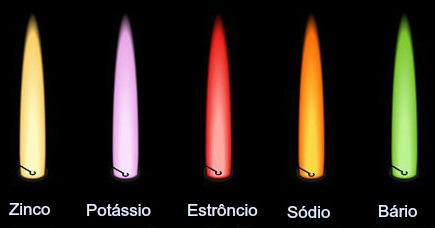Who doesn't like a fireworks show, right? The explosion of fireworks in the sky provides a beautiful light show that always pleases the vast majority of people. But how does this happen, that is, how does the production of lights present in fireworks occur? If you don't know how to answer this question, at the end of the text you will no longer have this problem.
Before a more detailed study about fireworks themselves, we need to know the components of an atom, since the production of light in the sky during a fireworks show is related to the electrons of the atoms of one of the components of the fireworks.
Atom is the particle (small part) that forms matter and has as its main regions and components:
a nucleus (with protons and neutrons);
energy levels. Each energy level has an amount of electrons and each electron has a fixed amount of energy. An electron can receive more energy, but never lose the energy that is its own.
already theFireworks are basically made up of three components:
shell;
gunpowder;
star.
The shell is that paper tube you usually see someone holding during a fireworks show. This tube is filled with black powder and, in the middle of it, the stars are placed. These stars are globes (“bags”) that always have four ingredients. Are they:
combustible material;
oxidizing agent;
metal composite;
binder.
The combustible material is needed to promote the star's explosion. Generally the materials used as fuel are phosphorus and sulfur. Oxidants produce the oxygen necessary for the explosion to occur, and the most used are nitrates and perchlorates. Metallic compounds, in turn, are metals used to promote the show's colors. The binder's function is to keep all the material mixed.
The shell with the gunpowder is used for the firework to explode on the ground and fly to higher places. During this journey, the star's oxidant produces oxygen, which reacts violently with the fuel, promoting the formation of various gases and a shock wave, which results in that explosion in the sky (which we perceive by the sound).
The explosion caused by the fuel and the oxidizer produces a great amount of energy. This energy produced stimulates the electrons present in the metal atoms contained in the star, which change their level of energy twice, that is, they leave their level of origin, go to another level, and then return to their level of origin. When electrons return to their original level, they release the energy received in the explosion in the form of light.
The lights produced in the sky depend on the metal that has been added to the firework star, as each metal has a different nature and therefore their electrons behave differently regarding the release of energy in the form of light. Below are the colors produced by each of the metallic chemical elements used in fireworks:
Barium: Green
Copper: Green
Calcium: Orange
Sodium: Yellow
Strontium: Red
Zinc: Bluish white
Aluminum, Titanium or Magnesium: Silver
Mixture of Strontium with Copper or Strontium with Potassium: Violet
Iron and Carbon Blend: Gold

Experiment that demonstrates the color of light produced by burning some metals
in short: when exploding in the sky, the electrons from the metal atoms present in the fireworks move to levels of energy different from yours and immediately return to the levels of origin, releasing the energy received in the form of light.
Now you are ready to explain to whoever you want how the lights emitted during a fireworks show are formed.
By Me. Diogo Lopes Dias


